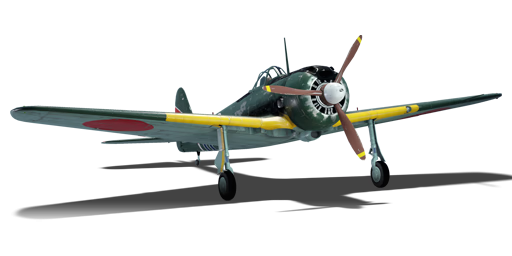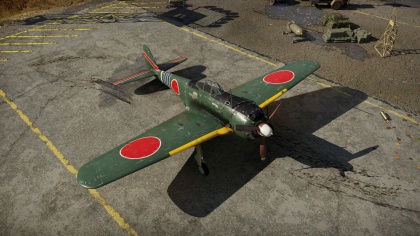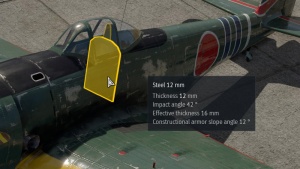Ki-43-II
Contents
| This page is about the aircraft Ki-43-II. For other uses, see Ki-43 (Family). |
Description
The Ki-43-II Hayabusa is a rank I Japanese fighter
with a battle rating of 2.3 (AB) and 2.7 (RB/SB). This fighter was introduced into the game sometime prior to Update 1.27.
General info
Flight Performance
| Characteristics | |||||||
|---|---|---|---|---|---|---|---|
| Stock | |||||||
| Max Speed (km/h at 6,000 m) |
Max altitude (meters) |
Turn time (seconds) |
Rate of climb (meters/second) |
Take-off run (meters) | |||
| AB | RB | AB | RB | AB | RB | ||
| 539 | 523 | 9800 | 15.7 | 16.3 | 11.9 | 11.9 | 190 |
| Upgraded | |||||||
| Max Speed (km/h at 6,000 m) |
Max altitude (meters) | Turn time (seconds) | Rate of climb (meters/second) |
Take-off run (meters) | |||
| AB | RB | AB | RB | AB | RB | ||
| 580 | 558 | 9800 | 14.7 | 15.0 | 19.6 | 15.3 | 190 |
Details
| Features | ||||
|---|---|---|---|---|
| Combat flap | Take-off flap | Landing flap | Air brakes | Arrestor gear |
| X | X | X | X | X |
| Limits | ||||
|---|---|---|---|---|
| Wing-break speed (km/h) |
Gear limit (km/h) |
Combat flap (km/h) |
Max Static G | |
| + | - | |||
| 0 | 300 | 523 | ~?? | ~? |
| Optimal velocities | |||
|---|---|---|---|
| Ailerons (km/h) |
Rudder (km/h) |
Elevators (km/h) |
Radiator (km/h) |
| < ??? | < ??? | < ??? | > ??? |
| Compressor (RB/SB) | ||
|---|---|---|
| Setting 1 | ||
| Optimal altitude | 100% Engine power | WEP Engine power |
| ?,??? m | ??? hp | ?,??? hp |
Survivability and armour
Unlike most of the Japanese airplanes around this BR, the Ki-43-II features an armor plate. It's 12 mm steel at 12° angle, protecting an entire body, legs and part of the head from rear firing angles. It's far from perfect protection, but significantly increases survival chances of the pilot. This is further improved by a large, 14-cylinder radial engine at the front, soaking up most of the incoming damage.
That said though, one of the biggest issues with survivability of the fighter are its not self-sealing fuel tanks, which once ignited will happily burn the entire fighter to the ground, not different from most of the Japanese fighters in the game.
Armaments
Offensive armament
The Ki-43-II is armed with two nose-mounted Ho-103 army (12.7 mm) machine guns (900 rpm, 250 rpg). Typically for Japanese airplanes Air Targets and Stealth belts are the preferred options, depending on the skill of the player and the game mode. 12.7 mm machine guns have an acceptable effectiveness, which is helped by their excellent location on the nose, making it easier to aim and land shots without worrying about convergence.
Suspended armament
Unlike its predecessor, Ki-43-II can be outfitted with bombs, featuring the following ordnance:
- Without load
- 2 × 100 kg Army Type 94 general-purpose bomb (total: 200 kg, 92 kg TNT)
- 2 × 250 kg Army Type 98 general-purpose bomb (total: 500 kg, 208 kg TNT)
- 2 × 50 kg Army Type 94 general-purpose bomb (total: 100 kg, 39.2 kg TNT)
Generally the choice of bombs should depend on the skill of the player, with smaller bombs getting increasingly difficult to destroy enemy targets, while at the same time giving far better flight characteristics. In terms of destroying armored targets there's a notable gap in performance, with bombs having a destructive radius of 5, 3, 2 meters for 250, 100, 50 kg bombs respectively, making 250 kg bombs a very potent weapon, even if it gives a huge decrease in performance (+1.9 s to turn time, comparing to +0.5 s with the 100 kg bombs).
Usage in battles
Describe the tactics of playing in an aircraft, the features of using vehicles in a team and advice on tactics. Refrain from creating a "guide" - do not impose a single point of view, but instead, give the reader food for thought. Examine the most dangerous enemies and give recommendations on fighting them. If necessary, note the specifics of the game in different modes (AB, RB, SB).
Manual Engine Control
| MEC elements | ||||||
|---|---|---|---|---|---|---|
| Mixer | Pitch | Radiator | Supercharger | Turbocharger | ||
| Oil | Water | Type | ||||
| Controllable | Not controllable | Not controllable | Not controllable | Separate | Not controllable | Not controllable |
Modules
| Tier | Flight performance | Survivability | Weaponry | ||
|---|---|---|---|---|---|
| I | Fuselage Repair | Radiator | |||
| II | Compressor | Airframe | |||
| III | Wings Repair | Engine | |||
| IV | Engine Injection | Cover | |||
Pros and cons
Pros:
- Extremely good roll rate
- Excellent stock performance
- Wins turn battles and can easily outrun opponents it typically faces
- Can equip bombs up to 100 kg to help aid weight and energy retention
- Fires can be easily extinguished
Cons:
- Very light, retains no energy
- Weak armour
- Very limited ammo pool
History
Describe the history of the creation and combat usage of the aircraft in more detail than in the introduction. If the historical reference turns out to be too long, take it to a separate article, taking a link to the article about the vehicle and adding a block "/ History" (example: https://wiki.warthunder.com/(Vehicle-name)/History) and add a link to it here using the main template. Be sure to reference text and sources by using <ref>, as well as adding them at the end of the article. This section may also include the vehicle's dev blog entry (if applicable) and the in-game encyclopedia description (under === In-game description ===, also if applicable).
In-game description
The single-seater Japanese Nakajima Ki-43 Hayabusa (Peregrine Falcon) fighter was designed to replace the Ki-27 in the Japanese Imperial Army’s Air Force.
The Ki-27 design was so successful that, without resorting to the competition that usually occurred among aircraft manufacturers, the Air Force authorized Nakajima to create an improved model. The main requirement for the new fighter was a high top speed of at least 500 km/h but with the same maneuverability as the Ki-27.
The first three prototypes were prepared and tested in 1939, but their maneuverability was inadequate. Therefore 10 pre-production aircraft with different configurations were considered. Two of them used the new “butterfly” combat flaps, which largely decided the issue. With the flaps, the plane became much more maneuverable.
In autumn of 1942, the Ki-42-IIA entered production. The main differences between the Ki-42-IIA and previous models were its more powerful Ha-115 motor, its 1130 hp output, and its three-bladed propeller (the previous model had a two-bladed propeller). The wings were reinforced to hold 250-kg bombs, and the lighter machine guns were replaced with large-caliber ones. In addition, the wing fuel tanks were self-sealing, and pilot protection was enhanced with 13 mm of armor (previous models, to lighten the aircraft, did not include protection for the pilot or fuel tanks).
All in all, 5919 Ki-43 fighters were produced, most of which were of the Ki-43-IIA design.
Media
See also
Links to the articles on the War Thunder Wiki that you think will be useful for the reader, for example:
- reference to the series of the aircraft;
- links to approximate analogues of other nations and research trees.
External links
Paste links to sources and external resources, such as:
- topic on the official game forum;
- encyclopedia page on the aircraft;
- other literature.
| Nakajima Aircraft Company (中島飛行機株式会社 ) | |
|---|---|
| Fighters | Ki-27 otsu · Ki-27 otsu Tachiarai |
| Ki-43-I · Ki-43-II · Ki-43-III otsu | |
| Ki-44-I · Ki-44-I 34 · Ki-44-II otsu · Ki-44-II hei | |
| Ki-84 ko · Ki-84 otsu · Ki-84 hei | |
| Ki-87 | |
| Hydroplanes | A6M2-N* |
| Interceptors | J1N1 · J5N1 |
| Bombers | B5N2 |
| B6N1 Model 11 · B6N2 Model 12 · B6N2a Model 12Ko | |
| G5N1 · G8N1 | |
| Ki-49-I · Ki-49-IIa · Ki-49-IIb · Ki-49-IIb/L | |
| Recon | E8N2 |
| Jet Fighters | Kikka |
| Captured | ␗Ki-27 otsu · ▃Ki-43-II · ␗Ki-43-III ko · ␗Ki-44-II hei · ␗Ki-84 ko |
| *Refit of the Mitsubishi A6M2 mod. 11 | |
| See also | Fuji Heavy Industries (1957-2017) |
| Japan fighters | |
|---|---|
| Navy | |
| Carrier-based fighter | |
| A5M | A5M4 · Hagiri's A5M4 |
| A6M | A6M2 mod. 11 · A6M2 · A6M3 · A6M3 mod. 22 · A6M3 mod. 22Ko · A6M5 · A6M5 Ko · A6M5 otsu · A6M5 Hei · A6M6c |
| A7He | A7He1* |
| A7M | A7M1 (NK9H) · A7M2 |
| Land-based Fighter | |
| J2M | J2M2 · J2M3 · J2M4 Kai · J2M5 · J2M5 (30 mm) |
| J6K | J6K1 |
| J7W | J7W1 |
| N1K-J | N1K1-Ja · N1K2-J · N1K2-Ja |
| Fighter seaplane | |
| N1K | N1K1 |
| A6M-N | A6M2-N |
| Army | |
| Ki-10 | Ki-10-I · Ki-10-I C · Ki-10-II · Ki-10-II C |
| Ki-27 | Ki-27 otsu · Ki-27 otsu Tachiarai |
| Ki-43 | Ki-43-I · Ki-43-II · Ki-43-III otsu |
| Ki-44 | Ki-44-I · Ki-44-I 34 · Ki-44-II otsu · Ki-44-II hei |
| Ki-61 | Ki-61-I ko · Ki-61-I otsu · Ki-61-I hei · Tada's Ki-61-I hei · Ki-61-I tei · Ki-61-II Otsu Kai |
| Ki-84 | Ki-84 ko · Ki-84 otsu · Ki-84 hei |
| Ki-87 | Ki-87 |
| Ki-94 | Ki-94-II |
| Ki-100 | Ki-100 · Ki-100-II |
| Other countries | ▅F4U-1A · ▅P-51C-11-NT · ▅Bf 109 E-7 · ▅Fw 190 A-5 |
| *Imported designation of the He 112 (A6M was in development - A7M would take A7 designation after the cancelation of the A7He) | |






